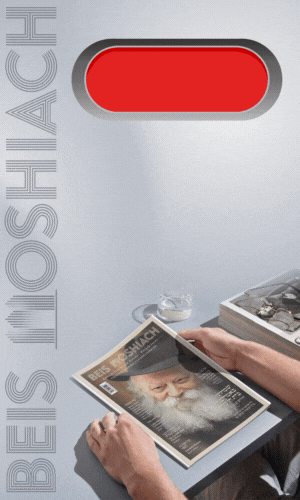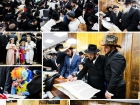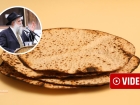Rabbi Nissim Lagziel: Camping Out In The Sukkah
From the desk of Rabbi Nissim Lagziel, mashpia in Oholei Torah: This week we will be celebrating Sukkos. Sukkos this year will focus on the mitzva of Hakhel which the Rebbe elaborated on so many times and demanded that every single person be involved in “gathering the nation… so that they will hear and learn and fear G-d.” • Full Article
By Rabbi Nissim Lagziel
BEGIN WITH A GRIN
Two fellows went camping. Having arrived late at night, they pitched their tent and went straight to sleep. At around midnight, one of them woke up and looked at the stars.
He called to his friend, “Look! The stars! Do you know what that means?”
The friend responds, “That the stars are other planets and there could be life out there?”
He replies, “No, you fool, it means that somebody stole our tent.”
HAPPY VS. UNHAPPY CAMPERS
This week we will be celebrating Sukkos. Sukkos this year will focus on the mitzva of Hakhel which the Rebbe elaborated on so many times and demanded that every single person be involved in “gathering the nation … so that they will hear and learn and fear G-d.” (Devarim 31:12)
No doubt, every one of us yearns for the fulfillment of the mitzva of Hakhel with the true and complete Geula with the Rebbe MH”M, who will read to us “the words of this Torah.”
However, not only Hakhel connects Sukkos to the Geula. In the Gemara we find very interesting mentions of the connection of Sukkos and the Geula. In the Gemara (Avoda Zara 3a) it says that in the Geula, when we get the incredible reward for fulfilling mitzvos, the goyim will come with a complaint that if only they had had the opportunity to do mitzvos like Jews, they would have done just as well. G-d will say, “Fools … the one who works on erev Shabbos [i.e. the Jewish people who kept mitzvos in the harsh exile] will eat on Shabbos, and those who did not work on erev Shabbos [i.e. the goyim], what will they have to eat on Shabbos?”
Still, G-d does not cheat His creations. If they want a chance to do mitzvos, they will be given a chance. “I have an easy mitzva and sukka is its name. Go and do it … Immediately, each one will get to work and make a sukka on his rooftop.” G-d decides to test the nations, to give them a little “taste” of the suffering and difficulties that the Jews went through in exile. In order to see who and what He is dealing with, to see their determination and readiness to withstand hardships, but just a little … after all, they are goyim.
“G-d heats up the sun over them like in tekufas Tammuz [the height of summer] and each of them kicks the sukka and leaves.” A bit of sun and they’re outta there. Come and look at the Lubavitchers who sit in the sukka in cold and heat, rain and snow…
However, the mitzva of sukka is not just a technical justification in regards to the nations, but a fitting reward for the Jewish people. The Gemara says (Bava Basra 75a) that “in the future, G-d will make a sukka for tzaddikim out of the skin of the livyasan, as it says, ‘Will you fulfill [your desire] to make sukkos of his skin.’” This marvelous sukka is connected to and goes hand in hand with the famous meal which G-d will hold for the tzaddikim when the menu will be livyasan, shor ha’bor, and and fine wine – yayin meshumar. But then the question arises, every beginner student knows that the skin of an animal, bird or fish is pasul for schach (the roofing for the sukka). Schach needs to be vegetation that grows from the ground which is cut, and that to which impurity does not attach. “Something that does not grow from the ground, like the skins of an animal … are not used as a covering” (Shulchan Aruch, Orach Chaim, 629, 1). Since when is the skin of the livyasan something that grows from the ground?
ACTUAL SUKKA OR JUST A MAJESTIC TENT?
And this is not just some exotic legend but an actual halachic debate that pertains even today, in exile. The Rema paskens at the end of Hilchos Sukka (667, 1) “and some have the custom that when they leave the sukka they would say, may it be His will that we merit to sit in the sukka of the livyasan.” The Aruch L’Ner, Rabbi Yaakov Ettlinger, a famous rav from Altona, in his sefer Bikkurei Yaakov, wonders about this wording that is found in siddurim, that we merit to sit in a sukka of livyasan skin when this is invalid for schach. How can we make this wish?
He suggests interpreting the “may it be His will” to referring to a sukka not for the mitzva but a structure made for beauty any time of the year. Alternatively, that we merit to eat the livyasan at the meal on Sukkos in a kosher sukka that is covered properly.
The big problem is that this wording appears back in the time of the Rishonim, starting with the Smak and the Kolbo and even famous commentators on the Talmud (like the Maharasha in Chiddushei Aggados) explained that this is the sukka used for the mitzva that is made of fish skin. How is this possible?
Some wanted to explains that since the sukka of livyasan skin is mentioned in Bava Basra in proximity to the special meal mentioned above, and about that meal the Medrash says that G-d will arrange an animal battle, what the ancient Romans called a ‘venatio’ to amuse the tzaddikim, and the shor ha’bor will “perforate the livyasan with its horns and rip it,” and at the same time, “the livyasan will perforate the animal with its fins and slaughter it.” It is about this that the Medrash asks, “Is this kosher shechita?” G-d says, “a new Torah will go forth from Me (Yeshaya 51:4) a novel ruling in Torah will go forth from Me.” So just like in the future, G-d will issue a new ruling that shechita is kosher with fins, so too, he will issue a new ruling that a sukka made of fish skin is kosher.
This becomes clearer in light of the marvelous chiddush of the Rebbe in connection with the shechita of the shor ha’bor with the fish’s fins. First, there is the famous question (which we’ve addressed before), how does this fit with the principle of the Torah that the Torah will never change and it will have nothing added or removed?
The Rebbe explains (second day of Shavuos 5751) that Moshiach will reveal, with his infinite wisdom, how the laws of shechita in the Torah to begin with weren’t said about this shechita, and therefore, the meat of the shor ha’bor will be kosher.
Based on this, perhaps we can say that here too, Hashem will reveal a chiddush in Torah that the law about the schach needing to be only from ground wasn’t said about this sukka, the sukka of tzaddikim made of fish skin!
It’s interesting to note that on an earlier occasion, in 5750, when finishing the blessing to guests who came for Sukkos, the Rebbe, most unusually, referred to the subject and suggested an interesting and radical solution to this entire complicated subject.
“The fulfillment of the mitzva of sukka, the eating in the sukka, does not pertain to a sukka of fish skin for the fish skin is invalid for schach, and therefore, they will need to jump back and forth, from the sukka to the sukka made of fish skin, and from the sukka made of fish skin to the sukka, and so on, back and forth.” (Hisvaaduyos 5750, vol. 1, p. 145)
So, prepare for the fact that we may need to jump to the regular sukka to say l’chaim on the yayin ha’meshumar and then go back to the sukka of tzaddikim made of fish skin to continue learning the “new Torah that will go forth from Me,” even this Sukkos!
TO CONCLUDE WITH A STORY
We will end with a story about another sukka that was very hard to make kosher. One time, the Baal Shem Tov made a sukka that was full of halachic questions that the greats of Mezhibuzh were inclined to invalidate. The Baal Shem Tov argued that the sukka was kosher and placed his head on his hand for a few moments and then opened his hand and in it was a piece of parchment. On it was written, “This sukka of Rabbi Yisrael Baal Shem Tov is kosher, says Matat Sar ha’Pnim.”
This piece of parchment was handed down as an heirloom to the grandson of the Baal Shem Tov, author of Degel Machneh Ephraim of Sedlikov.
It once happened that there was a sick person in town and they went to the author of the “Degel,” he said to place the note under the head of the sick man. When they did so, he immediately recovered.
This went on for two years, that they would place the note under the pillow of a sick person and he would recover. Nobody died in the town of Mezhibuzh.
Then, one time, they put the note under a sick person and the note disappeared!
The Rebbe once explained this story (second day of Sukkos 5727) saying that the Baal Shem Tov built himself a sukka that was halachically questionable in order to “lift up” the sukkos of simple people who could not find the means to make a sukka that was halachically sound and they had to suffice with one that was kosher b’dieved.
The Baal Shem Tov taught the gedolim of Mezhibuzh that a true leader is someone who is willing to forgo his hiddur mitzva if he knows that by doing so he will help another Jew, even if he is only one the simplest of the simple!
Chag Somayach and good Shabbos!
40
Join ChabadInfo's News Roundup and alerts for the HOTTEST Chabad news and updates!








































